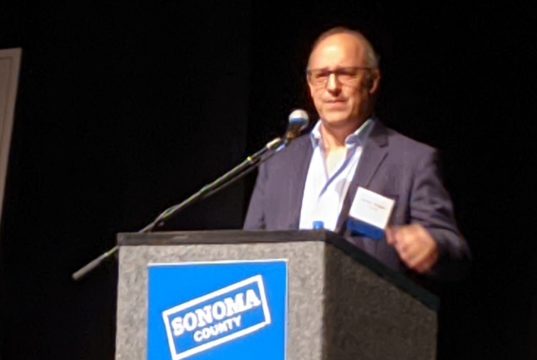This year the Sonoma County Winegrowers’ annual Dollars and $ense meeting was held in conjunction with the Sonoma County Vintners, and Glenn Proctor, Board of Directors Chairman for the Sonoma County Winegrowers opened by commenting on the tough forecast for the wine industry by stating that it is “More Important than ever for vintners and growers working together,” and that “It will add value to the future of Sonoma wine country.”
“The sky is not falling, but we are seeing some trends that we want to turn around,” said Danny Brager, Senior Vice-President, Beverage Alcohol and Cannabis Practices, Nielsen before diving into the details of how wine sales have performed over the past year.
In 2019 the total volume of wine sold declined, but the value went up 1.1% for total wine, but only 0.2% for still wine, indicating that consumers are continuing to buy more expensive wine. Wines priced above $10 are still seeing growth. However, there is reason to be concerned; total alcohol consumption per capita is flat, and wine’s share is shrinking. “We’re battling for share,” said Brager. “This year for the first year since 2000, wine’s share of alcohol consumption has gone down.”
For Sonoma wines Brager noted that there are still positives. 26 of 100 top Sonoma wine brands are growing with double digits, and “Sonoma is growing in both dollars and volume, because we’re in those categories (above $10) that are growing.”
Wine categories that are still seeing growth include sparkling wines, which are up in dollars, but down in volume, rose, and direct to consumer shipments. “The DTC trend has come down, just like retail, but it is still growing, just not as fast as before,” said Brager of the decline from above 20% growth in 2018 to 5% in 2019.
The rosè category is still growing, but also less from 33%, 45%, and 37%, in previous years to 14% in 2019. However, compared to France “We [the US] continue to command a larger share of the rosè category,” noted Brager. The US share of rosè sales expanded from 33% in 2017 to 47% in 2019 while France’s share declined from 53% to 43%, making US producers now the largest source of rosè wines in the US market.
Inside the alcohol group, the growing segments that wine are competing with are spirits and hard seltzers. Hard seltzers are considered part of the beer category, but was a non-existing category only a few years ago, is experiencing 200% growth and is already bigger than Pinot Noir with $1.6B in sales in 2019.
However, not all of those hard seltzer dollars are coming out of wine’s share; 53% are seltzer consumers buying more , 5% are new consumers, and 42% are dollars shifting from other alcoholic beverages, with about one dollar in four coming from wine. “It’s a sign of newer consumers, younger consumers,” said Brager, and to compete wine needs to “ay attention to newest drinking age consumers.”
To help understand how consumer behavior is changing, Brager laid out some of the trends Nielsen can see in their data and from their consumer surveys. Two of those trends that hard seltzers play into include health/wellness and convenience. They are low in calories and almost always come in a can.
“It [cans] are a trend,” said Brager. Wine in cans saw a 79% value growth in 2019 vs only 0.5% for bottled, and cans are now 0.7% of the wine category. Cans are also seeing growth in other beverages like beer, cider, and RTD drinks. “There’s something going on with convenience,” said Brager. “We’ll continue to see that trend line grow.”
Another aspect of convenience is eCommerce. “As a share of eCommerce for alcohol wine dominates,” said Brager, “if we can keep 76% share that’s good for us.” However, while eCommerce sales of wine grew 20% in 2019, it was outpaced by beer at 50% and spirits at 29%.
Brager cautioned the wine industry to find a way to speak to the trending health and wellness consciousness. According to Nielsen surveys, “The number one reason for drinking less is health and wellness.” And the people who drink wine are over indexed in the group of health and wellness conscious consumers.
“What’s the onramp?” Asked Brager rhetorically at the end of his talk. “We don’t do well with multicultural and younger generations. We’ve got to get that younger consumer to try wine, and maybe they’ll like it.”
He pointed to wine based cocktails and flavored wine that could be the young consumers’ entry into the wine market. Much of it is in cans and exists in multiple flavors like hard seltzers.
By Kim Badenfort
